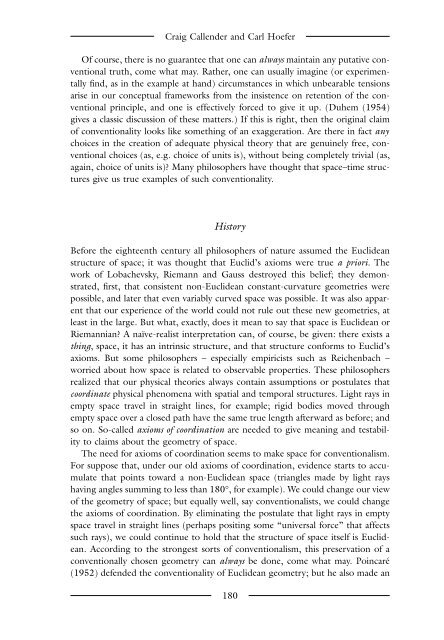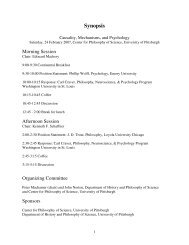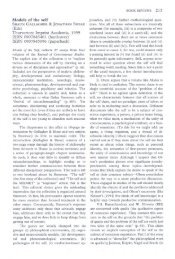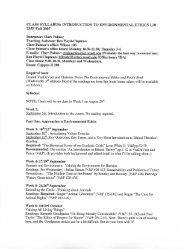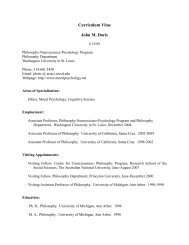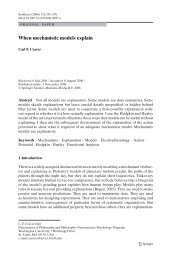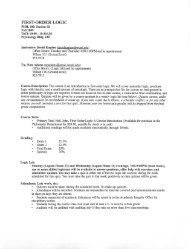The Blackwell Guide to the Philosophy of Science - The Department ...
The Blackwell Guide to the Philosophy of Science - The Department ...
The Blackwell Guide to the Philosophy of Science - The Department ...
Create successful ePaper yourself
Turn your PDF publications into a flip-book with our unique Google optimized e-Paper software.
Craig Callender and Carl Hoefer<br />
Of course, <strong>the</strong>re is no guarantee that one can always maintain any putative conventional<br />
truth, come what may. Ra<strong>the</strong>r, one can usually imagine (or experimentally<br />
find, as in <strong>the</strong> example at hand) circumstances in which unbearable tensions<br />
arise in our conceptual frameworks from <strong>the</strong> insistence on retention <strong>of</strong> <strong>the</strong> conventional<br />
principle, and one is effectively forced <strong>to</strong> give it up. (Duhem (1954)<br />
gives a classic discussion <strong>of</strong> <strong>the</strong>se matters.) If this is right, <strong>the</strong>n <strong>the</strong> original claim<br />
<strong>of</strong> conventionality looks like something <strong>of</strong> an exaggeration. Are <strong>the</strong>re in fact any<br />
choices in <strong>the</strong> creation <strong>of</strong> adequate physical <strong>the</strong>ory that are genuinely free, conventional<br />
choices (as, e.g. choice <strong>of</strong> units is), without being completely trivial (as,<br />
again, choice <strong>of</strong> units is)? Many philosophers have thought that space–time structures<br />
give us true examples <strong>of</strong> such conventionality.<br />
His<strong>to</strong>ry<br />
Before <strong>the</strong> eighteenth century all philosophers <strong>of</strong> nature assumed <strong>the</strong> Euclidean<br />
structure <strong>of</strong> space; it was thought that Euclid’s axioms were true a priori. <strong>The</strong><br />
work <strong>of</strong> Lobachevsky, Riemann and Gauss destroyed this belief; <strong>the</strong>y demonstrated,<br />
first, that consistent non-Euclidean constant-curvature geometries were<br />
possible, and later that even variably curved space was possible. It was also apparent<br />
that our experience <strong>of</strong> <strong>the</strong> world could not rule out <strong>the</strong>se new geometries, at<br />
least in <strong>the</strong> large. But what, exactly, does it mean <strong>to</strong> say that space is Euclidean or<br />
Riemannian? A naïve-realist interpretation can, <strong>of</strong> course, be given: <strong>the</strong>re exists a<br />
thing, space, it has an intrinsic structure, and that structure conforms <strong>to</strong> Euclid’s<br />
axioms. But some philosophers – especially empiricists such as Reichenbach –<br />
worried about how space is related <strong>to</strong> observable properties. <strong>The</strong>se philosophers<br />
realized that our physical <strong>the</strong>ories always contain assumptions or postulates that<br />
coordinate physical phenomena with spatial and temporal structures. Light rays in<br />
empty space travel in straight lines, for example; rigid bodies moved through<br />
empty space over a closed path have <strong>the</strong> same true length afterward as before; and<br />
so on. So-called axioms <strong>of</strong> coordination are needed <strong>to</strong> give meaning and testability<br />
<strong>to</strong> claims about <strong>the</strong> geometry <strong>of</strong> space.<br />
<strong>The</strong> need for axioms <strong>of</strong> coordination seems <strong>to</strong> make space for conventionalism.<br />
For suppose that, under our old axioms <strong>of</strong> coordination, evidence starts <strong>to</strong> accumulate<br />
that points <strong>to</strong>ward a non-Euclidean space (triangles made by light rays<br />
having angles summing <strong>to</strong> less than 180°, for example). We could change our view<br />
<strong>of</strong> <strong>the</strong> geometry <strong>of</strong> space; but equally well, say conventionalists, we could change<br />
<strong>the</strong> axioms <strong>of</strong> coordination. By eliminating <strong>the</strong> postulate that light rays in empty<br />
space travel in straight lines (perhaps positing some “universal force” that affects<br />
such rays), we could continue <strong>to</strong> hold that <strong>the</strong> structure <strong>of</strong> space itself is Euclidean.<br />
According <strong>to</strong> <strong>the</strong> strongest sorts <strong>of</strong> conventionalism, this preservation <strong>of</strong> a<br />
conventionally chosen geometry can always be done, come what may. Poincaré<br />
(1952) defended <strong>the</strong> conventionality <strong>of</strong> Euclidean geometry; but he also made an<br />
180


